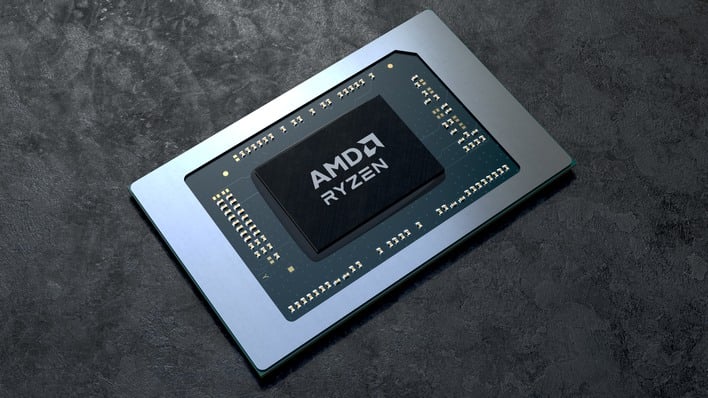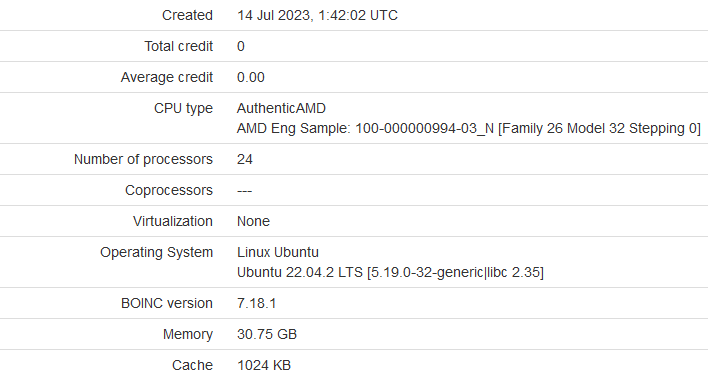AMD Ryzen 8000 Series Strix Point Zen 5 CPU Breaks Cover With 12 Cores
AMD and Intel have rather similar mobile strategies at this point. Both companies ship two types of laptop CPUs—larger chips, marked "HX", which are based on silicon that is also used for desktop CPUs, and then smaller processors that are specifically intended for mobile usage. These are typically marked H, HS, P, or U, these days.
Typically, the biggest difference in the mobile-focused CPUs is that they trade the high core counts and large caches of the desktop chips for significantly improved graphics horsepower. That's true of AMD's current Ryzen 7040 series CPUs, codenamed "Phoenix"—they drop half the cores and half the cache per core of a "Dragon Range" desktop-class CPU, but they also include a powerful 8-TFLOP RDNA 3 GPU on-die.
The latest leak seems to confirm the specification of twelve cores, as MilkyWay@Home reports the "AMD Eng Sample: 100-=000000994-03_N" as having 24 processors. It's counting logical cores, so 24 threads means twelve cores unless AMD has done something really drastic with Zen 5, but we don't think that's the case. Interestingly, the MilkyWay@Home leak also confirms the L2 cache per core as being 1MB, the same as Zen 4 and one-half of Intel's Raptor Cove CPUs.
What will be interesting to see is exactly what mix of cores Strix Point ships with. We know it will use Zen 5, but rumors have said that AMD's Zen 5 processors may be a hybrid architecture. We do know that, unlike Intel, AMD's "big" and "little" chips will share the same instruction set and have the same IPC. It'll likely be the same situation as with Zen 4 and Zen 4c, where the "c" low-power cores (as seen in Bergamo) are much denser, run at lower clocks, and have less cache, but are otherwise identical to a standard Zen 4 CPU core.
With that in mind, it's possible that Strix Point will ship with four, six or, eight "Zen 5" cores and then an additional four, six, or eight "Zen 5c" cores. If that's not enough CPU cores for you, there are rumblings that Strix Point will ship alongside a special "Strix Halo" part that has 16 cores and a much larger RDNA 3.5 GPU. Based on the rumored specifications—40 compute units in the GPU—it sounds more like something we would see in a game console rather than in a laptop or desktop PC, but all we can do for now is wait for more news.
Typically, the biggest difference in the mobile-focused CPUs is that they trade the high core counts and large caches of the desktop chips for significantly improved graphics horsepower. That's true of AMD's current Ryzen 7040 series CPUs, codenamed "Phoenix"—they drop half the cores and half the cache per core of a "Dragon Range" desktop-class CPU, but they also include a powerful 8-TFLOP RDNA 3 GPU on-die.
Intel's latest mobile-oriented processors (non-HX) come with six P-cores and eight E-cores at a maximum, putting AMD on the back foot when comparing like for like. That may not last long, though. According to leaks, AMD's next mobile parts will be codenamed Strix Point, and will sport twelve hot new Zen 5 CPU cores as well as a revised RDNA 3+ GPU.
MilkyWay@Home result. Thanks to @Benchleaks for the tip.
The latest leak seems to confirm the specification of twelve cores, as MilkyWay@Home reports the "AMD Eng Sample: 100-=000000994-03_N" as having 24 processors. It's counting logical cores, so 24 threads means twelve cores unless AMD has done something really drastic with Zen 5, but we don't think that's the case. Interestingly, the MilkyWay@Home leak also confirms the L2 cache per core as being 1MB, the same as Zen 4 and one-half of Intel's Raptor Cove CPUs.
What will be interesting to see is exactly what mix of cores Strix Point ships with. We know it will use Zen 5, but rumors have said that AMD's Zen 5 processors may be a hybrid architecture. We do know that, unlike Intel, AMD's "big" and "little" chips will share the same instruction set and have the same IPC. It'll likely be the same situation as with Zen 4 and Zen 4c, where the "c" low-power cores (as seen in Bergamo) are much denser, run at lower clocks, and have less cache, but are otherwise identical to a standard Zen 4 CPU core.
With that in mind, it's possible that Strix Point will ship with four, six or, eight "Zen 5" cores and then an additional four, six, or eight "Zen 5c" cores. If that's not enough CPU cores for you, there are rumblings that Strix Point will ship alongside a special "Strix Halo" part that has 16 cores and a much larger RDNA 3.5 GPU. Based on the rumored specifications—40 compute units in the GPU—it sounds more like something we would see in a game console rather than in a laptop or desktop PC, but all we can do for now is wait for more news.



